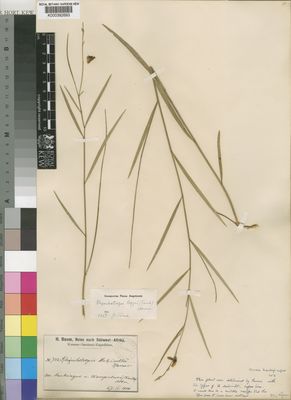Legumes of the World. Edited by G. Lewis, B. Schrire, B. MacKinder & M. Lock. Royal Botanic Gardens, Kew. (2005)
-
Note
-
Polhill (1981f) recognised 4 genera and c. 710 species in Indigofereae. This treatment following Polhill (1994), Schrire (1995), Barker et al. (2000) and Schrire et al. (2003) recognises 7 genera and c. 768 species in the tribe (Fig. 44). The Indigofereae are predominantly African-Madagascan in distribution, occurring in seasonally dry vegetation types of the tropics and subtropics. The genus Indigofera (third largest in the Leguminosae) is pantropical in distribution.
Recent morphological-molecular analyses (Pennington et al., 2000a; Crisp et al., 2000; Wojciechowski et al., 2000, 2004; Hu, 2000; Kajita et al., 2001; Hu et al., 2002 and Wojciechowski, 2003) place Indigofereae at the base of a combined millettioid group of tribes (including Millettieae, Abreae, Phaseoleae, Desmodieae and Psoraleeae). This entire clade is sister to Hologalegina (comprising the robinioids and the Inverted Repeat Lacking Clade (IRLC)). Basally branching to these two clades are the South African Hypocalypteae and Australian tribes Mirbelieae and Bossiaeeae.
The Indigofereae (Barker et al., 2000; Schrire et al., 2003) comprises a Cyamopsis, Indigastrum, Microcharis and Rhynchotropis (CRIM) clade which is sister to the Indigofera-Vaughania clade. The Madagascan Phylloxylon is putatively the most basally branching genus in the tribe, although in some analyses in Schrire et al. (2003), Phylloxylon is sister to the CRIM clade.
Flowers often before the leaves are produced; sister genus to Microcharis (Barker et al., 2000)
-
Habit
-
Herbs
-
Ecology
-
Seasonally dry tropical woodland and wooded grassland, often in seasonally damp or open sandy and rocky areas
-
Distribution
-
SC Africa in the N of the Zambezian regional centre of endemism (White, 1983)


